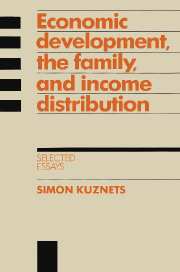Book contents
- Frontmatter
- Contents
- Preface by Louis Galambos and Robert Gallman
- Foreword by Richard A. Easterlin
- 1 Driving forces of economic growth: what can we learn from history?
- 2 A note on production structure and aggregate growth
- 3 The pattern of shift of labor force from agriculture, 1950–70
- 4 Modern economic growth and the less developed countries
- 5 Notes on demographic change
- 6 Recent population trends in less developed countries and implications for internal income inequality
- 7 Demographic aspects of the size distribution of income: an exploratory essay
- 8 Size and age structure of family households: exploratory comparisons
- 9 Size of households and income disparities
- 10 Distributions of households by size: differences and trends
- 11 Children and adults in the income distribution
- Afterword: Some notes on the scientific methods of Simon Kuznets by Robert William Fogel
- Bibliography of Simon Kuznets
- Index
5 - Notes on demographic change
Published online by Cambridge University Press: 12 November 2009
- Frontmatter
- Contents
- Preface by Louis Galambos and Robert Gallman
- Foreword by Richard A. Easterlin
- 1 Driving forces of economic growth: what can we learn from history?
- 2 A note on production structure and aggregate growth
- 3 The pattern of shift of labor force from agriculture, 1950–70
- 4 Modern economic growth and the less developed countries
- 5 Notes on demographic change
- 6 Recent population trends in less developed countries and implications for internal income inequality
- 7 Demographic aspects of the size distribution of income: an exploratory essay
- 8 Size and age structure of family households: exploratory comparisons
- 9 Size of households and income disparities
- 10 Distributions of households by size: differences and trends
- 11 Children and adults in the income distribution
- Afterword: Some notes on the scientific methods of Simon Kuznets by Robert William Fogel
- Bibliography of Simon Kuznets
- Index
Summary
These notes raise questions about the economic consequences of demographic trends, consequences in terms of what the trends imply for the rate of economic advance and for the distributive aspects of economic growth. These are questions rather than answers, for lack of firm basis for the latter; and even the questions are selective. The two trends chosen for comment are: the long-term decline in birthrates, associated largely with increasing control of intramarital fertility; and the long-term rise in the proportion of population in advanced ages (65 and over), associated largely with the recent impact of health technology in reducing mortality at the higher ages.
The natural concentration in Professor Easterlin's paper on the recent, forty-year swing in fertility, left little room for noting the underlying downtrend. Yet it is conspicuous in Easterlin's table 4.A.1, from the 1870s to World War II; and even within the swing itself, the average birthrate declined, from 22.3 per thousand in the four quinquennia of 1935–55 to 19.5 per thousand in the twenty-three years from 1955 to 1978. The consensus of the present projections suggests further decline. According to the latest, 1978, assessment (medium variant) by the United Nations, the average for 1955–60 to 1975–80 (the latter weighted by half) of 19.8 per thousand will drop to an average of 15.8 for 1975–80 (weighted by half) through 1995–2000.
- Type
- Chapter
- Information
- Economic Development, the Family, and Income DistributionSelected Essays, pp. 78 - 86Publisher: Cambridge University PressPrint publication year: 1989

